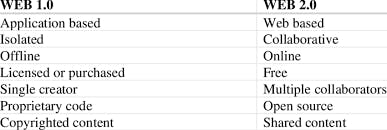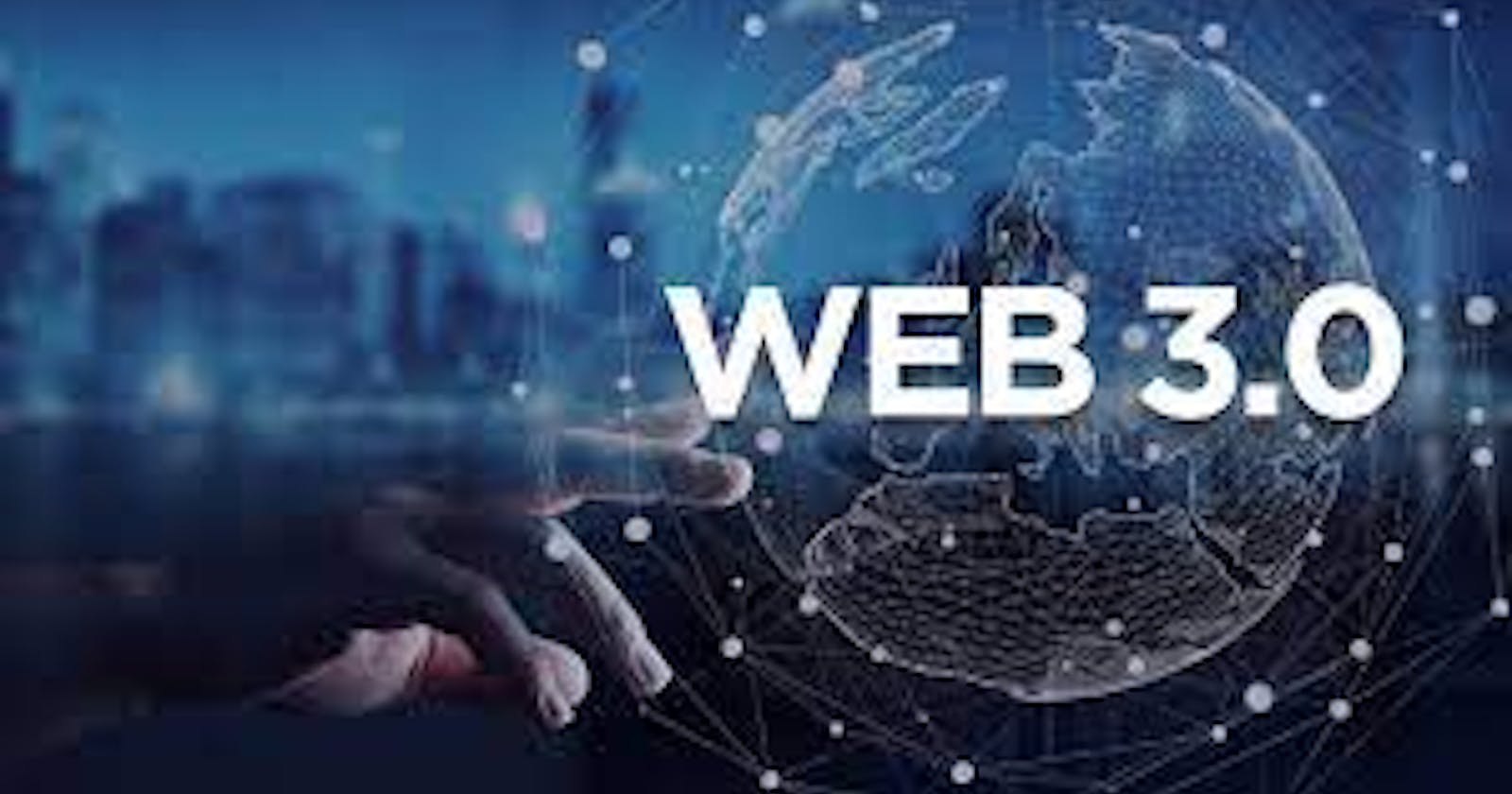Before we learn about what web 3.0 is, and proceed to having further insight on it, its essential we know the various layers of web we have in the tech industry. Namely: Web 1.0, Web 2.0, Web 3.0
what is web 1.0?
Web 1.0 was the first generation of the world wide web, also referred to as the read-only web. Web 1.0 began as an information place for businesses to broadcast their information and only allowed users to search for information and read it. Web 1.0 services are presentation-oriented content viewing services based on technologies supporting static Web pages (mainly hard-coded HTML pages) without much interaction, used to display information. Typical examples were simple homepages or directory services, such as Altavista, Yahoo, or Netscape, as well as basic supportive tools such as Web development tools (e.g., HTML editors) and basic search engines, such as AliWeb
What is web 2.0?
Web 2.0 (also known as participative web and social web) refers to websites that emphasize user-generated content, ease of use, participatory culture and interoperability (i.e., compatibility with other products, systems, and devices) for end users. When it comes to defining web 2.0. the term means such internet applications which allow sharing and collaboration opportunities to people and help them to express themselves online.
The difference shown below between some examples of Web 1.0 and 2.0 justifies why it’s time to move to the new version.

Advantages of Web 2.0:
Available at any time, any place. Variety of media. Ease of usage. Learners can actively be involved in knowledge building. Can create dynamic learning communities. Everybody is the author and the editor, every edit that has been made can be tracked. User-friendly. Updates in the wiki are immediate and it offers more sources for researchers. It provides real-time discussion.

What you need to know about web 3.0
Web 3.0 or Web3 is the third generation of the World Wide Web. Currently a work in progress, it is a vision of a decentralized and open Web with greater utility for its users. It is a stack of protocols (HTTP, SSH, FTP,SMTP), that enables fully decentralized application.
Web 3.0 is an idea for a new iteration of the World Wide Web which incorporates concepts such as decentralization, blockchain technologies, and token-based economics.
Web3 is the third generation of the internet currently being built, where websites and apps will be able to process information in a smart human-like way through technologies like artificial intelligence (AI), machine learning (ML), Big Data, decentralized ledger technology (DLT), and more.
WHAT IS THE 3RD ITERATION OF INTERNET?
- It's decentralized
- It is trustless: Everyone will use Zero Trust, and network protection will reach the edge.
- There's ownership of data
- Accept native payments
- Distributed and robust Infrastructure (utilization of cryptography): Interaction between devices, users, and services will be possible without a centralized authority's approval.
- Immutability (smart contract)
- It's open by nature: Open-source software will be used to build content platforms.
Blockchain Technology will make it possible for users to communicate directly with one another throughout the next stage of the internet. Users will communicate by becoming a part of a Decentralized Autonomous Organization (DAO), a group that is run and owned by its community.
Data belonging to the user will be protected via a network of openly available smart contracts. These contracts will be stored in a blockchain, which a decentralized network that nodes will control.
What Is Web3 Used For?
While Web3 technology is still very nascent, it already offers a number of distinct use cases. Here are the top 5 at present:
METAVERSE
The concept of the metaverse dominated tech headlines in 2022, with Facebook even rebranding to Meta and dropping billions into development in order to annex this new digital realm before anyone else could. Well, not so fast there Zuck. As Meta’s Q3 2022 earnings and tanking stock price have shown, investors and users are not very enthused about Facebook’s metaverse plans. The metaverse is essentially a virtual world — and can be thought of as a 3D version of the Internet and digital representation of the real world. Users can navigate either with computers, phones or VR/AR headsets, providing a deeply immersive experience that will increasingly blur the edges of reality.
BLOCKCHAIN GAMING
The success of Axie Infinity in 2021 kicked off the play-to-earn mania, promising gamers the opportunity to make money from playing games. Soon, thousands of copycat blockchain-powered games popped up offering lucrative rewards to players in the form of native tokens which skyrocketed at launch and then continued to tank.
SOCIAL NETWORK/ Creator Economy
One of the biggest gripes with Web 2.0 giants such as Facebook, YouTube and Spotify are that they don’t adequately reward artists and creators on their platforms for the visitors they pull in.
With Web3, creator communities of artists, writers, musicians, designers and developers will finally be able to bypass intermediaries and connect directly with their audiences and supporters. This will help them earn the bulk of any revenue generated in the process.
Decentralized Autonomous Organizations (DAOs)
Much has been said about the power of decentralized autonomous organizations (DAOs) to create a truly democratized and self-governing organization that will transcend human interference and geographical challenges through the power of smart contracts. While DAOs have taken some flak due to crypto projects tying it to governance tokens that soon become worthless, the need for DAOs still remain and this innovation could potentially exist as a dominant organizational structure once projects know how to optimally structure it.
Decentralized Finance (DeFi)
Decentralized finance (DeFi) exploded in value in mid-2020, offering cryptocurrency users the ability to invest, borrow, lend, trade and stake crypto assets permissionlessly. While DeFi faced its fair share of security issues like hacks and scams, the industry offers Web3 the opportunity to onboard potentially billions of users that have been neglected by traditional finance firms such as banks. DeFi products and services will undoubtedly be used in leading Web3 protocols looking to incentivize their users.
Web3, Cryptocurrency and Blockchain
As Web3 networks will operate through decentralized protocols — the founding blocks of blockchain and cryptocurrency technology — we can expect to see a strong convergence between these three technologies and other related fields. They will be interoperable, seamlessly integrated, automated through smart contracts and used to power anything from micro transactions, censorship-resistant P2P data file storage and sharing with applications, to completely changing every company conduct and operate their business.
WEB 2.0 to WEB 3.0 TRANSITION
- chrome to brave
- LinkedIn to Indoors
- PayPal to Trust wallet
- WhatsApp to Status
NOTE: Web 3.0 doesn't erase or replace the existing technology, it only increases the range of possible creations >
Key Features of Web3
To really understand the next stage of the internet, we need to take a look at the 5 key features of Web3:
Ubiquity
Semantic Web
Artificial Intelligence
Spatial Web and 3D Graphics
Decentralization through blockchain
Ubiquity
Ubiquity means being or having the capacity to be everywhere, especially at the same time. In other words, omnipresent. In that sense, Web 2.0 is already ubiquitous since, for instance, a Facebook user can instantly capture an image and share it, which then becomes ubiquitous since it's available to anyone no matter where they are, as long as they have access to the social media platform.
Web3 simply takes this a step further by making the internet accessible to everyone anywhere, at any time. At some point, internet-connected devices will no longer be concentrated on computers and smartphones like in Web 2.0 since IoT (Internet of Things) technology will bring forth a plethora of new types of smart devices.
Semantic Web
Semantic(s) is the study of the relationship between words. Therefore, the Semantic Web, according to Berners-Lee, enables computers to analyze loads of data from the Web, which includes content, transactions and links between persons. In practice, how would this look? Let’s take these two sentences, for instance:
- I love Bitcoin
- I <3 Bitcoin
Their syntax may be different, but their semantics are pretty much the same, since semantics only deals with the meaning or emotion of the content. Applying semantics in the Web would enable machines to decode meaning and emotions by analyzing data. Consequently, internet users will have a better experience driven by enhanced data connectivity.
Web 3.0 stack
- Layer 1 - Eth, Marachain, blockchain, solana, etc.
- Layer 2 - smart contracts (solidity, vyper, rust, etc.)
- Layer 3 - Node Providers
Layer 4 - Technological Primitives:
Decentralised file storage: IPFX, File on, truffle, remix, eth.org
Data feeds: Oracle
Identity Management
- Layer 5 - Front end Libraries
- Layer 6 - Communication Endpoints (ether.js, web3.js)
- Layer 7 - Browsers and Wallets
